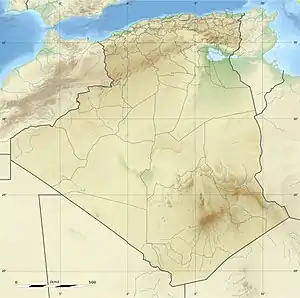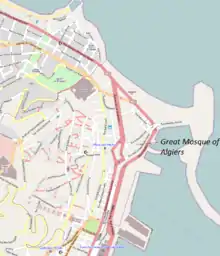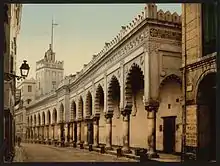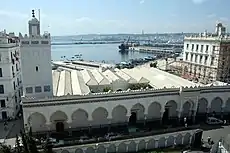Djamaa el Kebir
The Great Mosque of Algiers (Arabic: الجامع الكبير, Jemaa Kebir) or “Djama’a al-Kebir” (meaning Great Mosque) is a mosque in Algiers, Algeria, located very close to Algiers Harbor.[1] An inscription on the minbar (منبر) or the pulpit testifies to fact that the mosque was built in 1097. It is also known by several other names such as Grande Mosquée d'Alger, Djamaa al-Kebir, El Kebir Mosque and Jami Masjid. It is one of the few remaining examples of Almoravid architecture. It is the oldest mosque in Algiers and is said to be the oldest mosque in Algeria after Sidi Okba Mosque.[2] It was built under sultan Ali ibn Yusuf. Its minaret dates from 1332 (1324 in some sources) and was built by the Ziyyanid Sultan of Tlemcen. The gallery at the outside of the mosque was built in 1840. Its construction was a consequence of a complete reconstruction of the street by the French.[3][4][5]
| Great Mosque of Algiers | |
|---|---|
الجامع الكبير (in Arabic) Grande Mosquée (in French) | |
 Great Mosque of Algiers Djama’a al-Kebir | |
| Religion | |
| Affiliation | Sunni Islam |
| Year consecrated | 1097 |
| Location | |
| Location | Algiers, Algeria |
 Shown within Algeria | |
| Geographic coordinates | 36°47′7″N 3°3′51″E |
| Architecture | |
| Type | Mosque |
| Style | Islamic, Almoravid |
| Completed | 1097, 1324 and 1840 |
| Minaret(s) | 1 |
Geography

The Great Mosque is located in the northeastern part of the city in the historic Kasbah area near the harbor, next to the Chamber of Commerce. Earlier, the mosque was located on the Rue de la Marine in Algiers during French colonial rule of Algeria, which was then the entrance street to Algiers Harbor.[1][6] Rue de la Marine no longer exists and has been surpassed by the Rue d' Angkor and Boulevard de Ernesto Guevara and in the mosque area by a fork road called Rue Saadi et Mokhtar Ben Hafidh which it now lies on. The mosque is seen here with reordered portico of columns and poly-lobed arches that were built at the beginning of the colonial period. These precede the façade of the mosque, consequent to realignment of streets in the area.[4][5]
Architectural features

The mosque has a rectangular courtyard of 38×46 meters on a 9×11 grid. The narrow sides of the rectangle (with width larger than the perpendicular depth) have a riwaq (gallery). This layout has been replicated in many religious structures, e.g., the al-Aqsa Maghreb mosque in Algeria. While the main mosque was built in 1097 AD (Hegira 490), according to the minbar, the minaret on the north-western corner was a later addition (according to an inscription at its base), in 1332, by sultan Ali ibn Yusuf. The gallery surrounding the main mosque was added in 1840.[5][7]
The prayer hall is subdivided into eleven balatat (naves) supported by whitewashed masonry pillars. Each nave is crowned by a double sloping roof known as Moorish arches. The prayer hall is aligned below the first five of the nine bays that run parallel to the qibla wall.[3][5]


The mihrab, which was originally built as an integral part of the mosque in 1097, was destroyed in bombing in AD 1682 (AH 1093).[9] The reconstructed mihrab is a typical design followed in 18th-century Algiers in the form of indented lobed arches at the end of the central and much wider nave. It is a simple fresco façade with two small spiral columns flanking it on either side with an ogive stucco arch seen in relief.[5] The mihrab is set in a niche with a flat floor. Adjoining the mihrab on either side there are two door openings which lead to small oblong rooms, one of which housed the minbar which used to be shifted on rails to the prayer hall for the Imam to say the daily prayers and give sermons. While the rails that were used to shift the minbar are still embedded in the floor, the minbar itself is now preserved in the National Museum of Antiquities and Islamic Arts in Algiers. It is one of the finest sculpted minbars of its type in Algeria.[7] It bears an inscription in Kufic script saying: بسم الله الرحمن الرحيم أتم هذا المنبر في أول شهر رجب من سنة تسعين وأربعمائة. الذي عمل محمد (In the name of Allah, the Compassionate, the Merciful. This chair has been completed the first of the month of Rajab of the year 490. Work of Muhammad).[7] The minbar is sculpted in wood fixed on wheels for free movement of the Almoravid period. It is patterned in the simple shape of the paneled minbar of the Great Mosque of Qairawan.[10]
An enclosed courtyard is part of the outer bays of the mosque structure. A feature that is not seen here is in the layout of the building. Early Almoravid mosques were built on a T-shaped plan, which is not seen in this mosque. However, its central aisle is wider than the others.[3]
Following the realignment of the main street of Rue de la Marine, substantial changes in the façade became an essential additional feature, as seen now in the form of “A portico of columns and poly-lobed arches.”[5] This gallery at the entrance to the mosque was built in 1840.
In another part of the mosque, in the north-east corner, is the Bâb al-Jenina which, along with the Minaret, is meant for the exclusive use of the imam of the mosque. It has several rooms for routine use. This structure's surface is indented with rectangular niches decorated by poly-lobed blind arches inlaid with blue and white ceramic tiles.[7]
Materials used in constructing the mosque were stone, brick, roofing tiles and wood, and ornamentation of ceramics and wood was applied.[7]
See also
References
- Waldie's select circulating library, Volume 6. Volumes 1354–1356 of American periodical series, 1800–1850. A. Waldie. 1835. p. 337.
- Hyam, Joseph C. (1900). The illustrated guide to Algiers: a "practical" handbook for travellers (2 ed.). The Anglo-French Press Association.
- "Great Mosque of Algiers". Arch Net. Archived from the original on 2011-06-29. Retrieved 2010-11-11.
- "The Great Mosque of Algiers (ÇáÌÇãÚ ÇáßÈíÑ Jemaa Kebir)". pbase. Retrieved 2010-11-11.
- Ali Lafer. "The Great Mosque (djamaa el-kebir)". Museum with no frontiers. Retrieved 2010-11-11.
- Temple bar, Volume 16. Ward and Lock. 1866. p. 193.
- "Great Mosque of Algiers". Quantara Mediterranean Heritage. Archived from the original on 2010-07-07. Retrieved 2010-11-11.
- "Great Mosque in the Marine Street, Algiers, Algeria". World Digital Library. Algeria. 1899. Retrieved 14 July 2013.
- "Great Mosque of Algiers – An Excellent Example of Almoravid Architecture". Algeria.com. Archived from the original on October 16, 2017. Retrieved November 11, 2010.
- Kuban, Doğan (1974). Muslim Religious Architecture: The Mosque and its Early Development, Volume 1. BRILL. p. 27. ISBN 90-04-03813-2. Retrieved 2010-11-11.
Further reading
- Alger, quelques-unes de ses mosquées, le Comité du Vieil Alger, Feuillets d'El-Djezaïr, Fondateur Henri Klein (1910), Éditions du Tell, 2003
- Bourouiba, R., Les inscriptions commémoratives des mosquées d’Algérie, Algiers, OPU, 1984, p. 81–86
- Bourouiba, R., L’art religieux musulman en Algérie, Algiers, S.N.E.D., 1983
- Bourouiba, R., Apports de l’Algérie à l’architecture religieuse arabo-islamique, Algiers, OPNA, 1956
- Devoulx, A., Les édifices religieux de l'ancien Alger, Algiers, Bastide, 1870
- Marçais, G., L’architecture musulmane d’occident, Tunisie, Algérie, Espagne et Sicile, Paris, Arts et Métiers Graphiques, 1954
External links
| Wikimedia Commons has media related to Great Mosque of Algiers. |
- Museum with no frontiers, Ali Lafer, The Great Mosque (djamaa el-kebir)
- "Fountain in Mosque of El Kebir, Algiers, Algeria (photo)". 1899 – via World Digital Library.

